Plain painted walls just sit there, waiting for someone to do something interesting. After designing hundreds of spaces across the country, I’ve noticed how the right wall treatment brings in texture, dimension, and personality—stuff you just don’t get with basic paint. Wall treatments do way more than traditional flat paint. They add tactile and visual richness, turning an ordinary wall into something that actually catches your eye.
Remember to repin your favorite images!
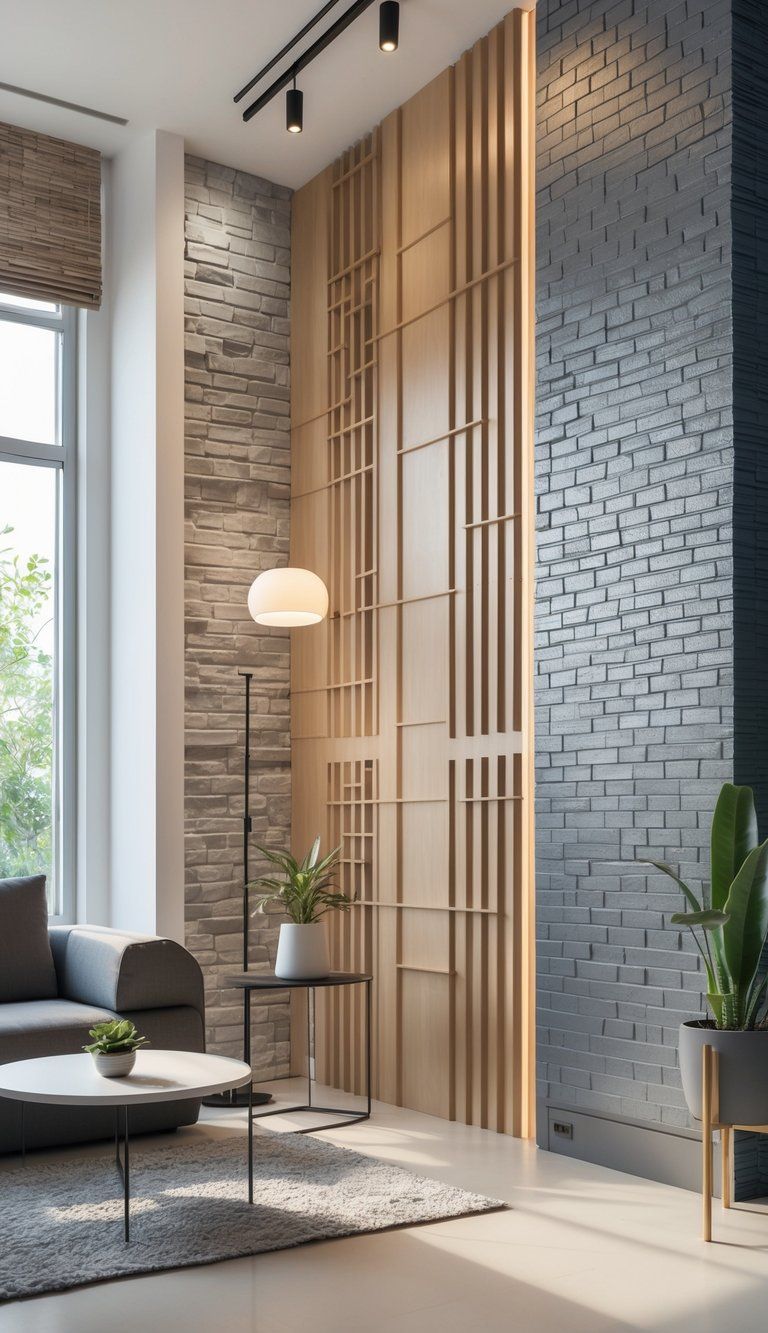
You might not realize how many options are out there. There’s everything from sophisticated Venetian plaster to textured stucco, or maybe some sleek wood paneling or mixed-material features. Each one sets a different mood in your home.
You don’t always need a pro, either. With the right tools and a little patience, you can pull off anything from subtle elegance to bold statement walls that really become the highlight of a room.
Let’s get into some creative alternatives I’ve used in high-end homes that you can totally try out yourself.
Understanding Distinctive Wall Treatments
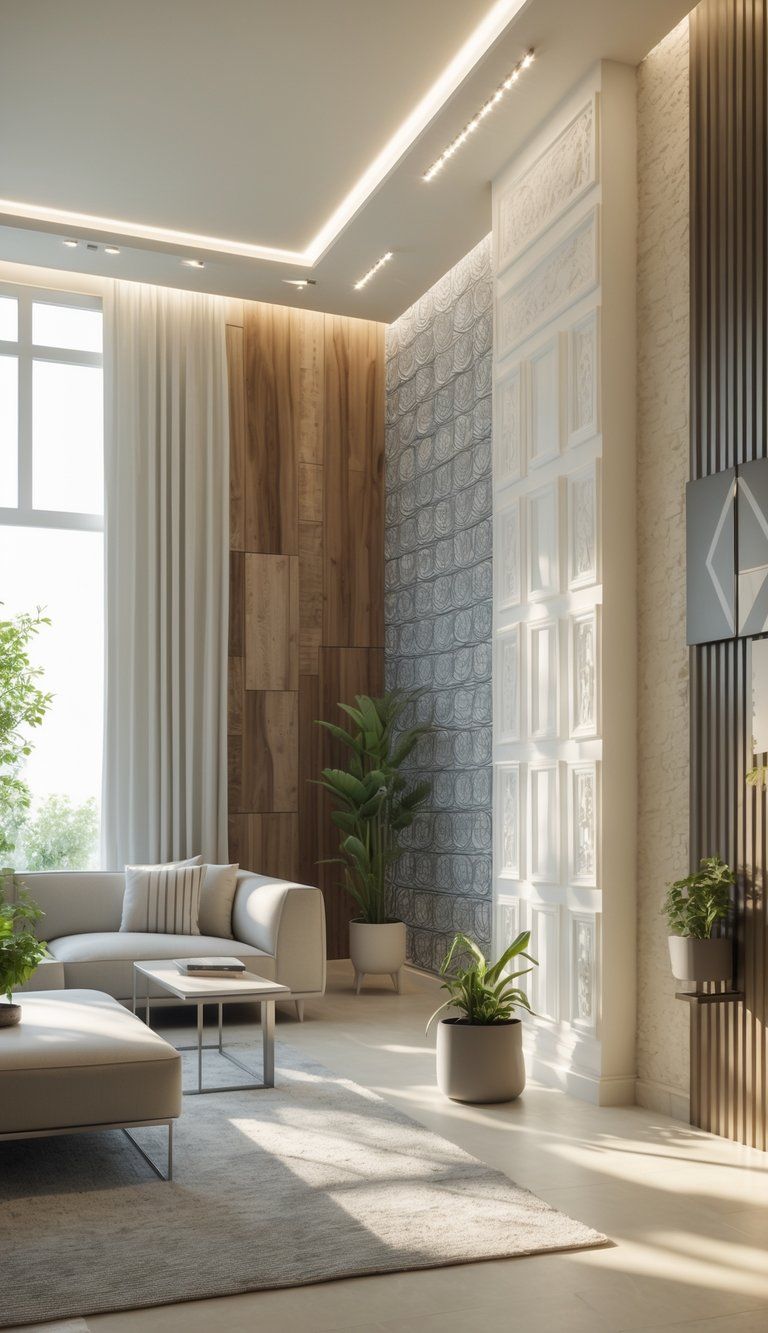
Wall treatments aren’t just about color—they’re about transforming a space. These details add texture, dimension, and personality to any room.
What Are Distinctive Wall Treatments?
Distinctive wall treatments use decorative techniques and materials to give walls way more interest than plain paint ever could. They turn boring walls into focal points that show off your style and boost your home’s vibe.
Think textured finishes, architectural elements, or applied materials that change how a wall looks and feels. Unlike just slapping on some paint, these treatments add depth with texture, pattern, or even a bit of dimension.
Some favorites:
- Textured paint techniques
- 3D wall panels
- Wood treatments like shiplap or reclaimed wood
- Decorative wall murals
- Applied materials—think stone, tile, or metal
Each one changes the mood in a different way and can totally shift the feel of a room, no major reno needed.
Why Go Beyond Plain Paint?
Plain paint is fine, but it’s kind of limited if you want texture or something eye-catching. Distinctive wall treatments bring in dimension that flat paint just can’t.
Wall treatments can:
- Create focal points that grab your attention
- Add texture and depth to flat walls
- Show off your personality with unique designs
- Help with acoustics in echoey rooms
- Boost home value by making your interiors stand out
You can even bring in natural stuff like wood or stone, which adds real warmth and character. Sometimes they even help fix weird room shapes or proportions.
A lot of these options are practical, too—some are easier to clean or stand up better in busy spaces.
Exploring Wall Treatment Options
There are so many wall treatment options now, you’ll probably find something for any style or budget. Knowing what’s out there helps you pick what fits your vision.
Textural Treatments:
- Venetian plaster for a soft, classy look
- Artistic paint techniques like rag rolling or color washing
- Textured wallpapers with raised designs
Architectural Elements:
- Wainscoting and chair rails for a classic feel
- Shiplap for that farmhouse or coastal vibe
- Board and batten for extra architectural detail
Statement Treatments:
- Wall murals that set a mood or tell a story
- 3D wall panels in cool patterns
- Living walls with real or faux plants
Think about the room’s purpose, your current décor, and how much maintenance you want. Some treatments are better in dry rooms, others are tough enough for busy spaces.
Popular Wall Treatment Materials
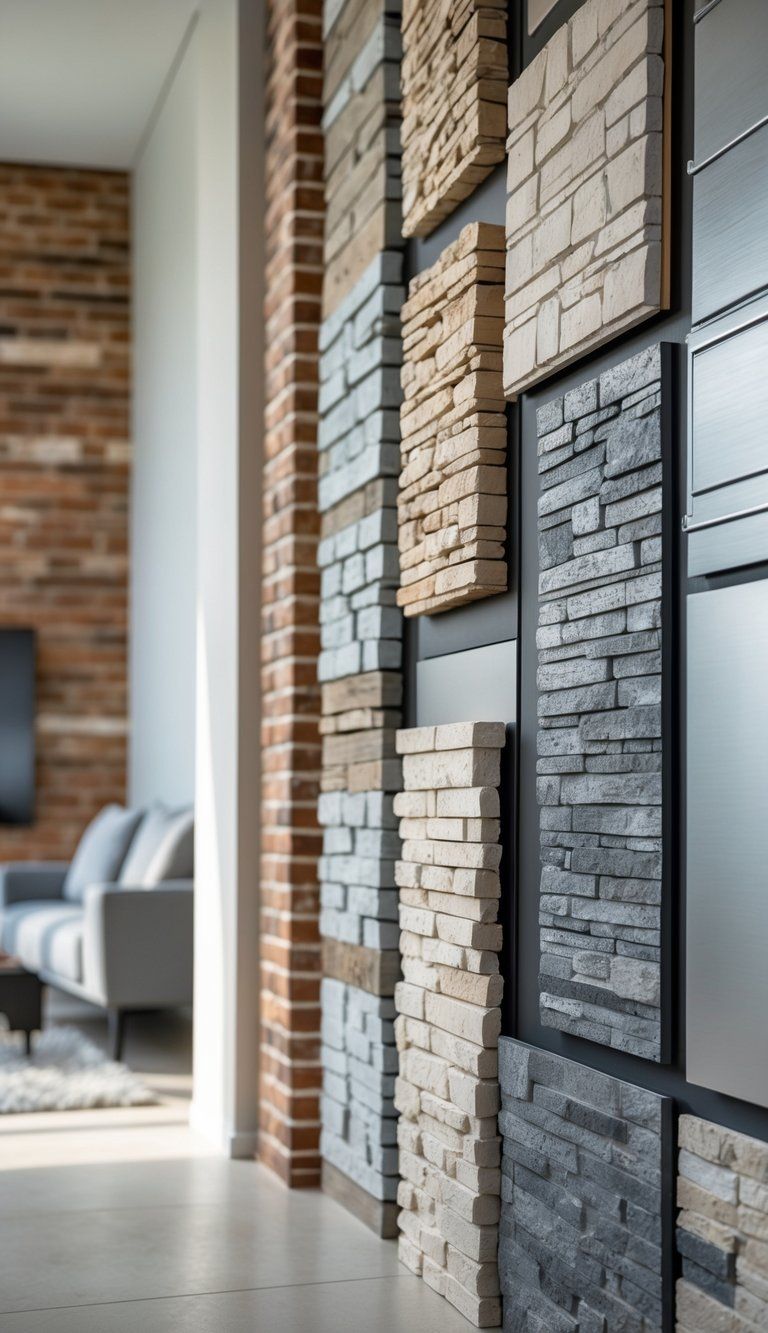
Wall treatments give your home character and personality, way beyond what you get with just paint. The right materials can take a plain wall and make it a real showstopper, adding texture and interest.
Wallpaper and Textured Wallpaper
Wallpaper’s made a big comeback lately. These days, you can find just about any pattern, color, or texture you want. Whether you like bold geometrics or something more subtle and natural, wallpaper can totally change a room in an afternoon.
Textured wallpaper goes even further by adding dimension. Some options:
- 3D geometric patterns for optical illusions
- Grasscloth for an earthy, organic vibe
- Flock wallpaper with a soft, raised feel
- Embossed designs that look like leather or fabric
Textured wallpapers work especially well in dining rooms, powder rooms, and bedrooms. They also do a great job covering up wall flaws while making your space feel a bit fancier.
Shiplap and Vertical Shiplap
Shiplap uses wooden boards installed horizontally, with little gaps for shadow lines and texture. It’s subtle but makes a big difference.
You’ll see shiplap a lot in:
- Farmhouse-style homes
- Coastal-inspired spaces
- Rustic-modern rooms
If you want something different, flip the boards and go vertical. Vertical shiplap can make ceilings look taller and gives a fresh twist.
DIY tip: Faux shiplap is a budget-friendly option. Just cut plywood into strips, use spacers, and paint them. White is classic, but bold colors can look fantastic too.
Board and Batten and Beadboard
Board and batten mixes wide boards with narrow strips (battens) to cover seams. You can go full wall or just partway up, depending on the look you want.
Board and batten looks great in:
- Entryways
- Dining rooms
- Bedrooms (behind the bed works well)
- Hallways
Beadboard uses skinny vertical boards with rounded edges, creating grooves. It started as a practical wall protector but now adds charm to bathrooms, kitchens, and mudrooms.
Both styles can be painted any color. White keeps things classic, while deep hues bring drama and a modern touch.
Natural and Reclaimed Materials
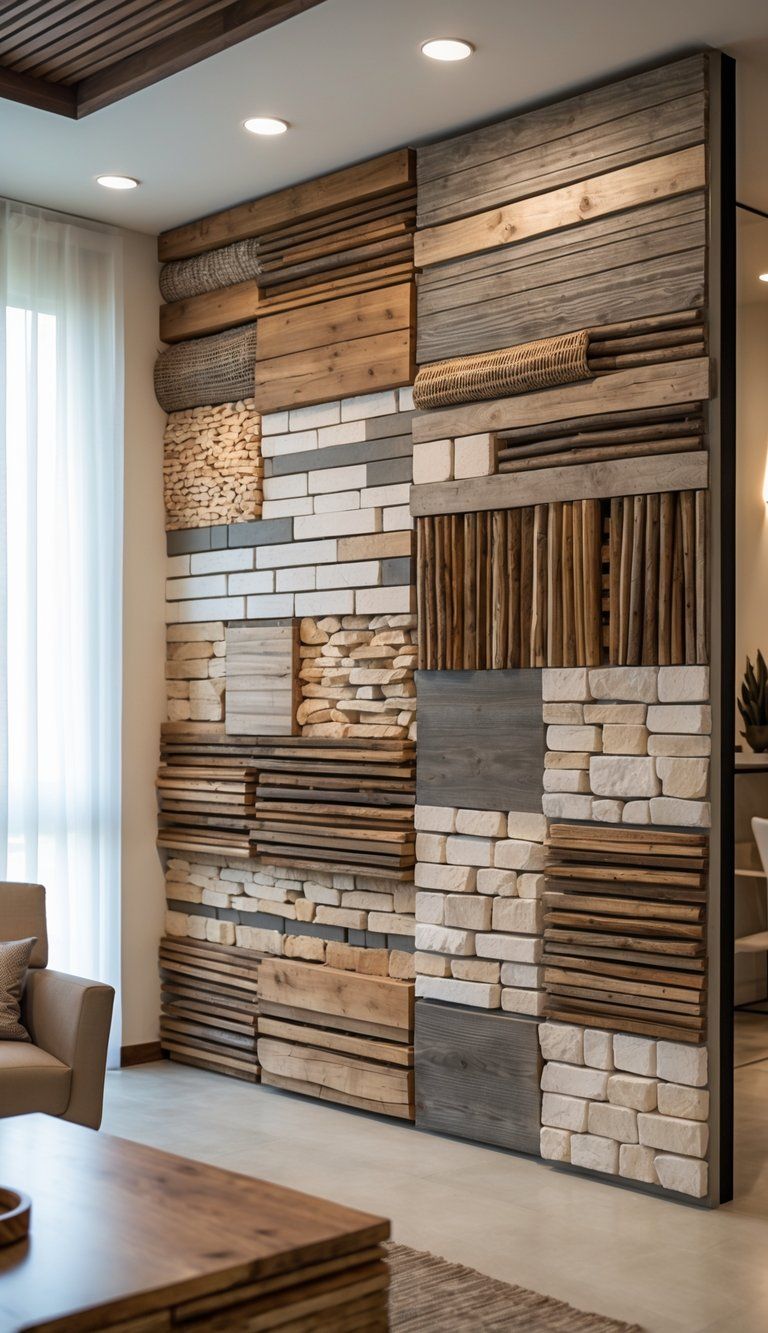
Natural and reclaimed materials give your walls character and a story, plus they’re more sustainable. They bring in texture, warmth, and a sense of history that paint just can’t.
Reclaimed Wood Walls
Reclaimed wood really transforms a wall, adding depth and a sense of the past. Each plank is different—with weathering, nail holes, and color shifts.
You can install reclaimed wood a few ways:
- Horizontal for a classic, farmhouse feel
- Vertical to make ceilings look higher
- Herringbone or chevron for a more upscale look
Barn wood, old floors, and even shipping pallets work well. Clean and treat the wood before using it. A clear sealant keeps the natural look and makes cleaning easier.
Costs vary a lot—usually around $5-25 per square foot, depending on the wood’s source and condition.
Stone Wall and Natural Textures
Stone walls add timeless style and last forever. You can go for limestone, slate, marble, or river rock—each one has its own look and feel.
If you’re on a budget, try:
- Stone veneers (thin slices of real stone)
- Manufactured stone (concrete made to look like stone)
- Clay or lime plaster for an organic, textured finish
Stone walls work best in entryways, around fireplaces, or as accent walls in bathrooms and kitchens. The way light hits the stone changes throughout the day, keeping things interesting.
You don’t have to do much to keep stone looking good—just dust it now and then and reseal every few years.
Living Walls and Green Elements
Living walls bring in greenery and help with air quality and sound. These vertical gardens liven up any room and make you feel closer to nature.
Options for living walls:
- Modular systems with planting pockets
- Panel systems with pre-grown plants
- DIY trellis setups for climbing plants
Pick plants based on how much light you get and how much care you want to give. Pothos, ferns, and succulents are easy choices. Most living walls need some sort of watering system, from simple hand watering to more advanced irrigation.
Professional living walls run about $100-200 per square foot, but you can save a lot with DIY. Besides looking cool, they help with air quality and humidity.
Creative Paint Techniques
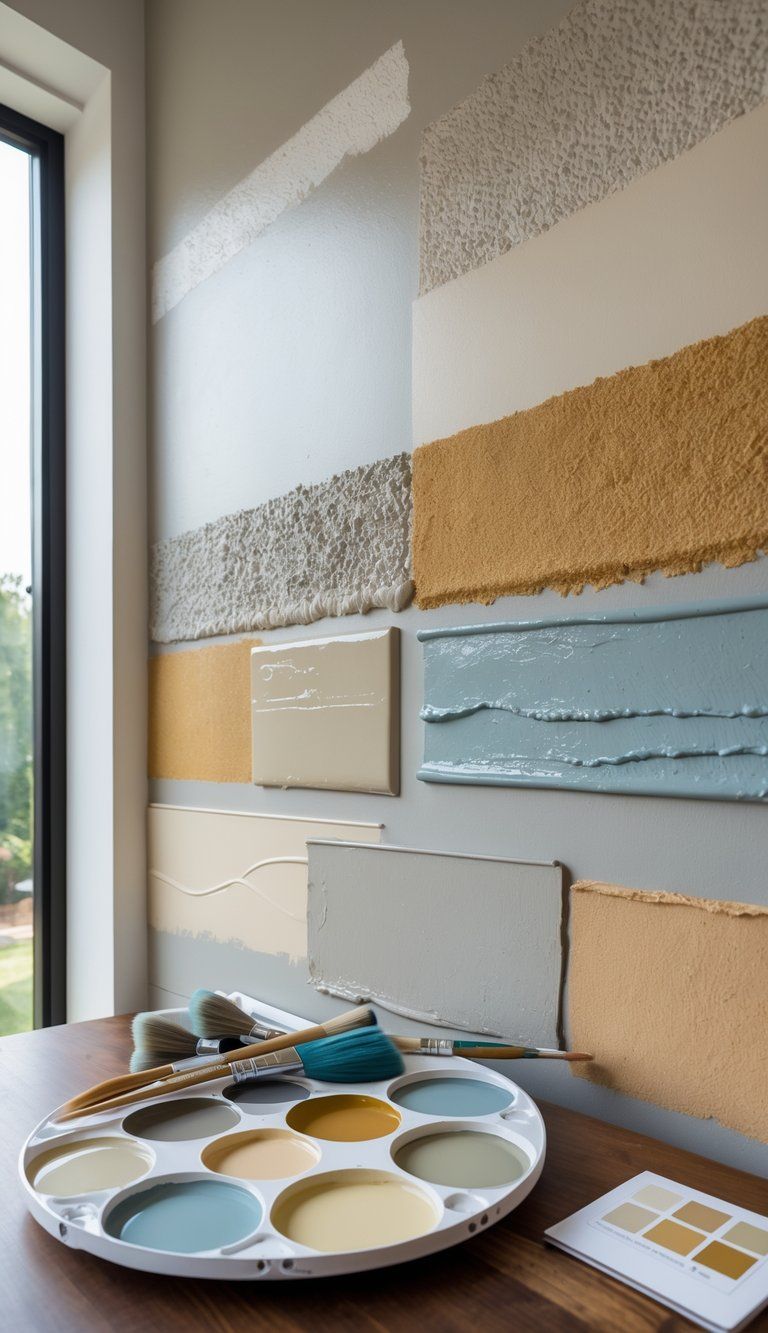
Paint doesn’t have to be boring. With a few tricks, you can add texture, depth, and visual interest—no major renovation needed.
Ombre and Color Washing
Ombre gives you that gradient effect from dark to light. Divide your wall into sections, paint each one a bit lighter, and blend them with a dry brush while the paint’s still wet.
Color washing adds depth with translucent layers. Mix 4 parts glaze with 1 part paint, then swirl it over your base coat using a rag or brush. The result is a soft, watercolor-like finish—great for dining rooms and living spaces.
Both methods hide wall flaws and give you a sophisticated look that shifts with the light.
Stenciling and Stenciled Walls
Stenciling is a fun way to get creative without committing to wallpaper. Use plastic or mylar stencils to make custom patterns—anything from geometrics to florals.
Tape down your stencil and use a foam roller or stencil brush with just a bit of paint. Dab, don’t brush, to avoid paint bleeding under the edges.
Big stencils make dramatic accent walls, while small repeating patterns can look like pricey wallpaper. Metallic paints add a little luxury, but tone-on-tone colors keep things subtle.
Try your stencil on cardboard first, and clean it between uses for sharp lines.
Sponging and Strié Technique
Sponging uses sea sponges or special rollers to create texture. After your base coat dries, dip the sponge in a contrasting color and dab in random spots. Change up the pressure for a more natural look.
If you want more control, try the “sponge-off” method: put glaze over your base, then lift some off with a damp sponge for a softer effect.
Strié gives you thin, vertical lines that almost look like fabric. Brush glaze over your base, then drag a dry brush down through it. This works especially well in formal dining rooms or entryways.
Both techniques add a touch of class, and you can keep it subtle or go bold with your color choices.
Checkerboard and Geometric Patterns
Geometric patterns make a big impact, especially in modern spaces. For checkerboard, use a level and painter’s tape to mark a grid, then paint alternating squares.
For more complex shapes:
- Use tape to outline triangles, diamonds, or hexagons
- Paint one color at a time and let each dry
- Peel off the tape while the paint is a little tacky
Think about the size—big patterns suit large rooms, while small ones fit powder rooms or tight spaces.
Color contrast really sets the mood: subtle combos add texture, bold colors bring drama. Always test your pattern on a small patch first to make sure you like the effect.
Textured Finishes and 3D Treatments
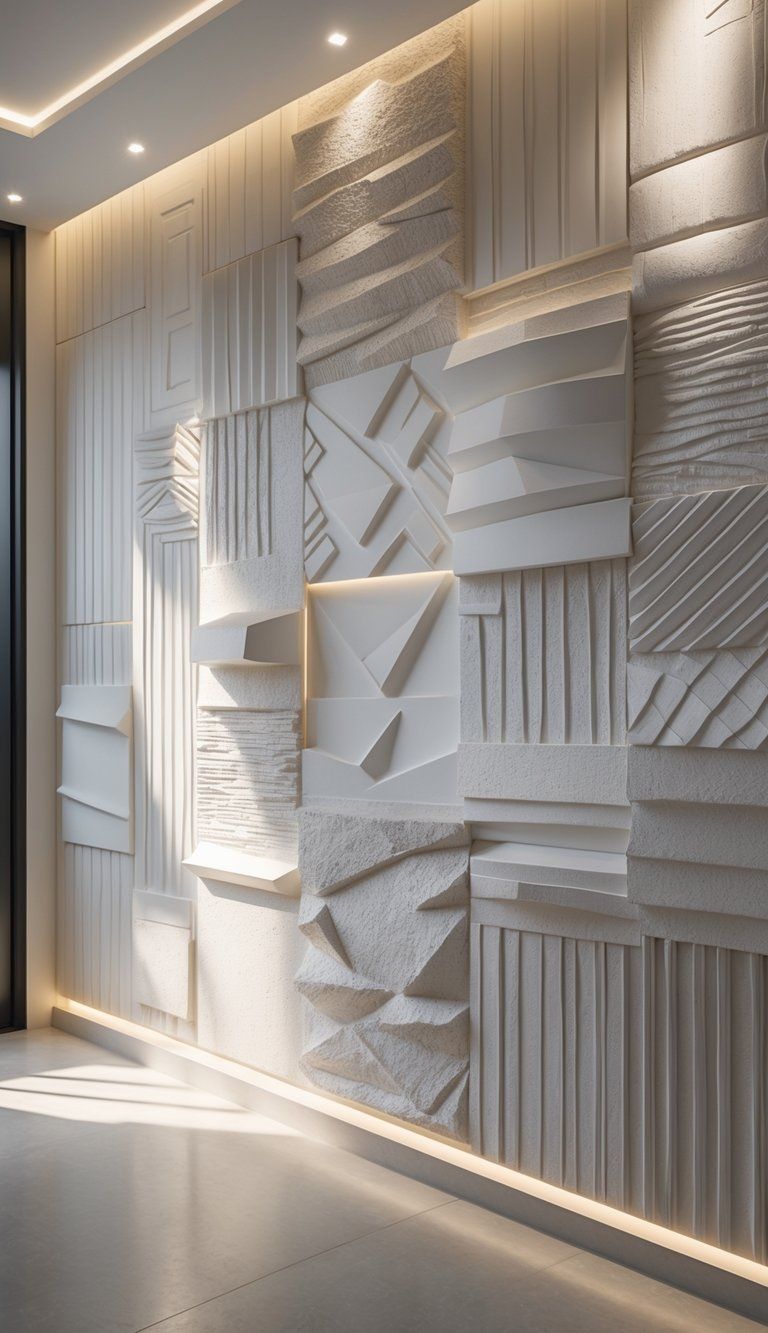
Wall textures give your home more depth and personality than plain old flat paint ever could. They hide flaws, draw the eye, and really turn boring walls into something you notice.
Venetian Plaster and Lime Plaster
Venetian plaster brings in a smooth, marble-like finish that just oozes timeless elegance. The mix of slaked lime and marble dust takes some work—lots of thin layers, each one carefully burnished to get that glossy, deep look.
If you want to try it yourself, grab a plaster labeled for Venetian use. Use a steel trowel and apply thin, overlapping strokes. Patience is everything here—let every layer dry before you go for the next.
Lime plaster feels more rustic and rough. It lets your walls breathe, so it’s great in bathrooms or kitchens where moisture hangs around. Plus, it’s a greener option than most synthetics, which is always nice.
Both finishes age well. Over time, they pick up a lovely patina that really gives your walls some character.
Knockdown, Orange Peel, and Popcorn Texture
Orange peel texture gives you a subtle, bumpy look—kind of like the surface of an orange. Just spray a thinned joint compound on the wall and let it dry. No fussing after that. It’s a good pick for bedrooms or living rooms where you want a little texture but nothing wild.
Knockdown texture starts with orange peel, then you flatten the peaks with a knockdown knife. The result is a rustic, stucco-like finish that’s become pretty popular lately—especially in modern homes. The changing light plays off the surface all day long.
Popcorn texture isn’t as trendy as it once was, but it still absorbs sound better than most wall finishes. Thankfully, new popcorn textures use safe, lightweight compounds instead of the dangerous stuff found in old houses.
You can tackle these textures yourself if you’re patient and have the right gear.
3D Wall Panels and Textured Wall Art
3D wall panels make a huge impact without much effort. You’ll find them in PVC, fiberboard, bamboo, and other materials, and most just stick up with construction adhesive.
Geometric patterns look sharp in modern rooms. Wave or floral designs feel a bit more traditional. Some panels even come with built-in LED channels, which look pretty amazing after dark.
Textured wall art lets you combine art with dimension. You can go with hand-carved wood, molded ceramic, or whatever suits your style to create a real focal point.
If you care about the environment, keep an eye out for panels made from recycled stuff or sustainable bamboo. Many options are paintable, so you can match your color scheme exactly.
Architectural Accents and Moldings
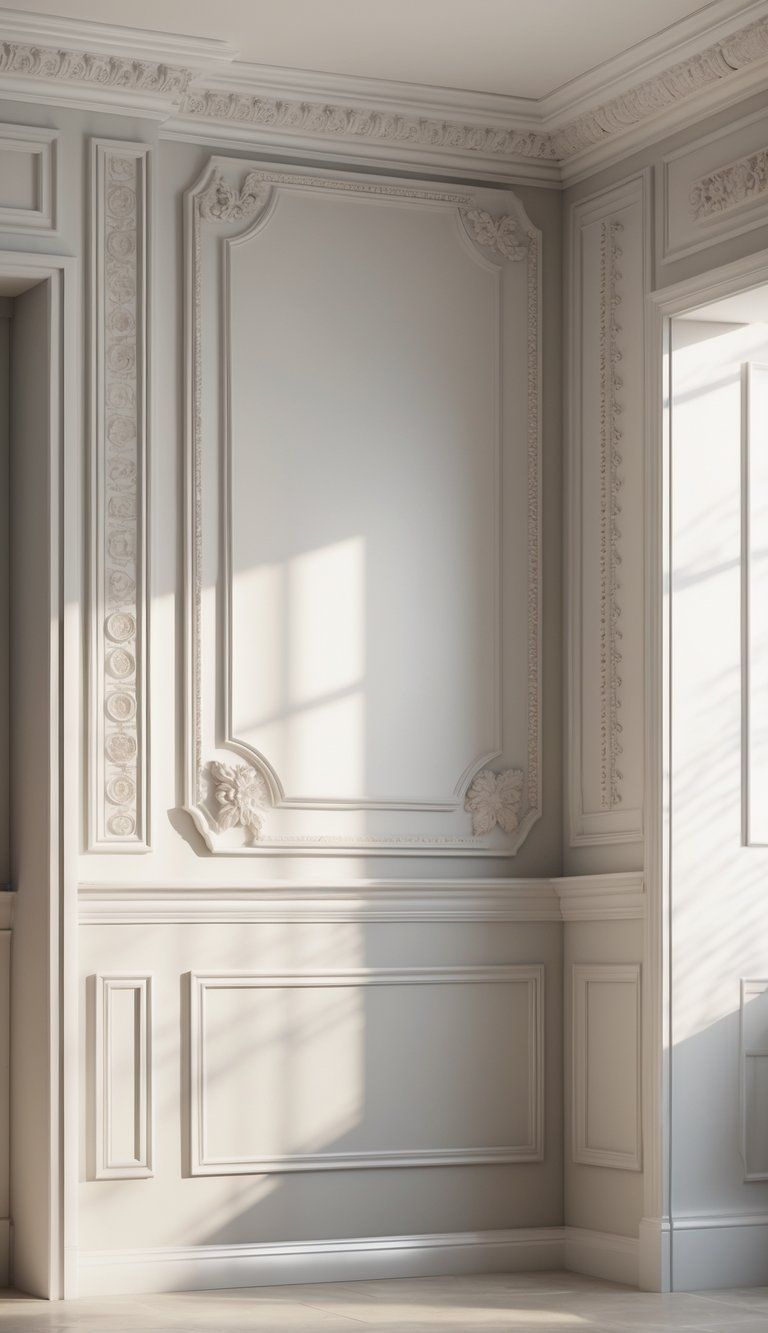
Architectural elements add depth and interest to your walls in a way paint just can’t. Moldings and trim can turn a basic room into something with history and a bit of wow factor.
Wainscoting and Wall Paneling
Wainscoting instantly brings in architectural detail. It usually covers the lower part of the wall, protecting it while looking good. Traditional wainscoting uses wood panels with raised or recessed bits, but you can also get MDF versions if you’re on a budget.
Wall paneling takes the idea further—covering more of the wall, sometimes all of it. Board and batten is a favorite; vertical boards and horizontal strips create simple geometric patterns. Entryways, dining rooms, and bedrooms all look great with this style.
You can paint these treatments to blend with your walls or pick a bold, contrasting color. White paneling on a colored wall always looks classic—no wonder designers love it.
Picture Frame Molding and Wall Molding
Picture frame molding lets you carve out elegant sections on your walls using thin decorative trim. It adds a touch of class without taking over the room. You can stick to simple rectangles or get creative with more complex shapes.
In rooms with high ceilings, lower wall molding helps break up tall walls and makes the space feel cozier. Crown molding, where the wall meets the ceiling, brings a polished finish and helps everything flow together.
Wall molding is quickly catching up to accent walls as the go-to way to add interest. These details tie your furniture and decor together and keep the room feeling balanced.
Think about your home’s style before you pick your molding. Traditional homes look great with ornate profiles. Clean, simple lines are better for modern spaces.
Artistic Statements for Walls
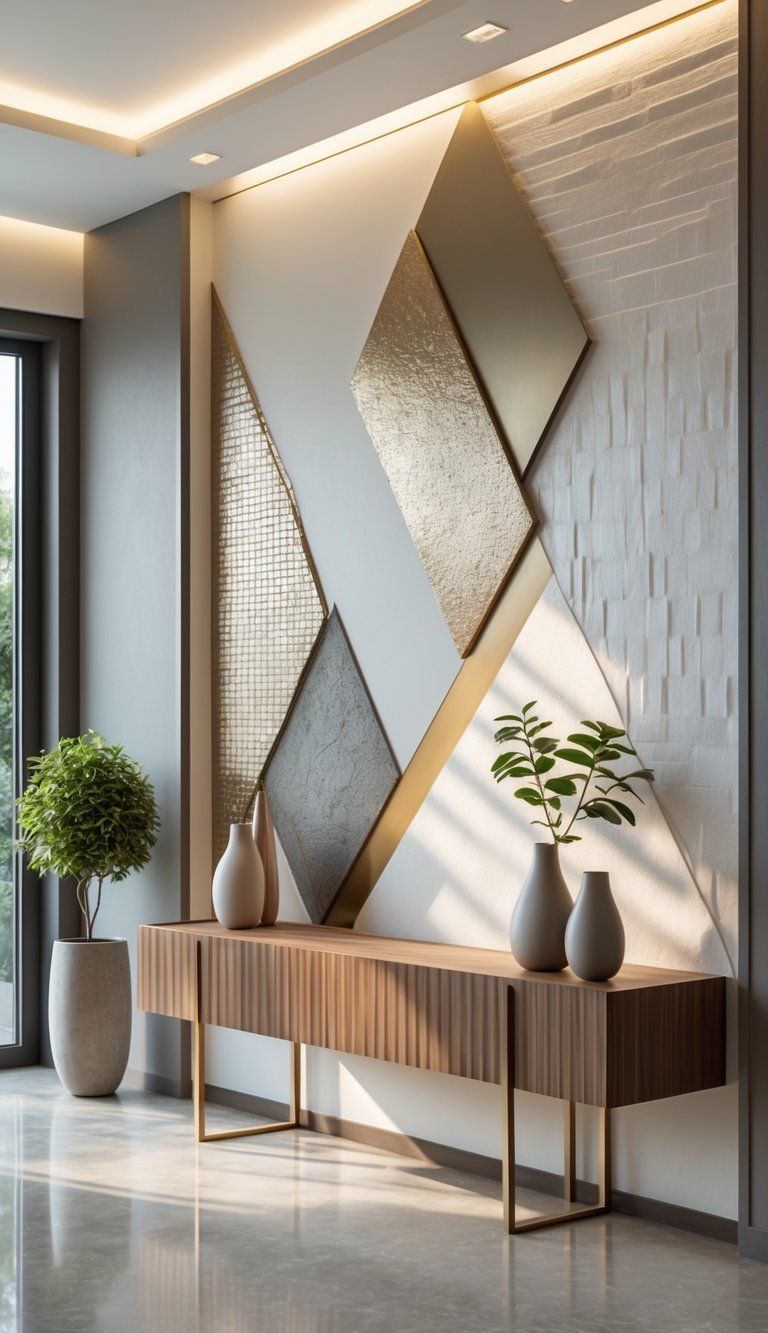
Your walls can be your biggest canvas. If you want to go beyond basic paint, there are plenty of artistic ways to add texture, depth, and interest—no major renovation needed.
Wall Murals
Wall murals instantly create a focal point and set the mood. They do way more than just add color—they tell stories.
Hand-painted murals are totally custom, but you’ll probably need some artistic chops or professional help. Prices vary a lot, usually between $10 and $100 per square foot depending on what you want.
Peel-and-stick mural wallpapers are a wallet-friendly option ($50-$300 per wall) and come in endless designs. You can put them up in just a few hours, no sweat.
If you want something in between, try mural stencils or project an image on the wall and trace it. You get a custom look without the pressure of freehand painting.
Murals shine in bedrooms, dining rooms, or entertainment zones—anywhere you want people to notice them.
Statement Walls and Accent Features
Statement walls draw the eye by standing out from the rest of the room. They anchor the space and highlight the best features.
Some favorite statement wall ideas:
- Geometric paint patterns using tape
- Wood accents like shiplap or reclaimed boards
- 3D panels or dimensional tiles
- Stone or brick veneer
- Textured finishes like limewash or plaster
Pick a wall that naturally grabs attention—behind a bed, sofa, or dining table works best. Try to avoid walls cluttered with doors or windows.
Balance matters. Your statement wall should work with your furniture, not fight it. Choose colors or textures that fit your palette instead of clashing.
Starched Fabric Wall Treatment
Starched fabric wall treatments are surprisingly versatile and won’t break the bank. This temporary trick uses fabric and liquid starch to make removable wall coverings.
Here’s how you do it:
- Choose a medium-weight fabric (cotton is easy)
- Cut it a bit bigger than your wall
- Roll liquid starch onto the wall
- Press the fabric into place
- Brush on more starch over the top
- Trim the edges
Best part? When you want a change, just peel it off and wash the wall. It’s perfect for renters or anyone who likes to switch things up.
Light quilting cottons, linen blends, or even vintage sheets all work nicely. Medium-sized patterns usually look best—tiny or huge prints can get lost or feel overwhelming.
Incorporating Patterns and Designs

Patterns and designs add a layer of interest that plain paint just can’t touch. These tricks can make a room feel way more lively and unique.
Herringbone Pattern
The herringbone pattern never really goes out of style. Its V-shaped layout creates movement and draws your eye across the wall.
You can pull off this look with:
- Wood planks for warmth and texture
- Tile (great for kitchens or baths)
- Wallpaper if you want to save money
- Paint and a lot of painter’s tape for the DIY route
Herringbone works for full walls or just as an accent. In smaller rooms, go for a bigger pattern to keep things from feeling too busy. It plays well with both modern and classic decor.
Colors change the vibe completely. Tone-on-tone herringbone feels subtle and elegant, while bold contrasts make a statement.
Geometrics and Modern Lines
Geometric patterns bring a fresh, modern edge to almost any room. You can keep it simple or go wild with more complex shapes.
Popular picks:
- Hexagons: For a honeycomb effect that’s modern but still feels organic
- Triangles: Add a bit of energy and movement
- Stripes: Horizontal stripes widen a room, vertical ones make ceilings look taller
Geometrics look awesome with modern furniture, but they can also add a cool twist to more traditional spaces. Wallpaper, painted designs, or even 3D panels all work.
Size matters here. Big patterns make a bold statement in large rooms, while smaller designs are better for cozy spaces.
Blending Wall Treatments With Home Decor
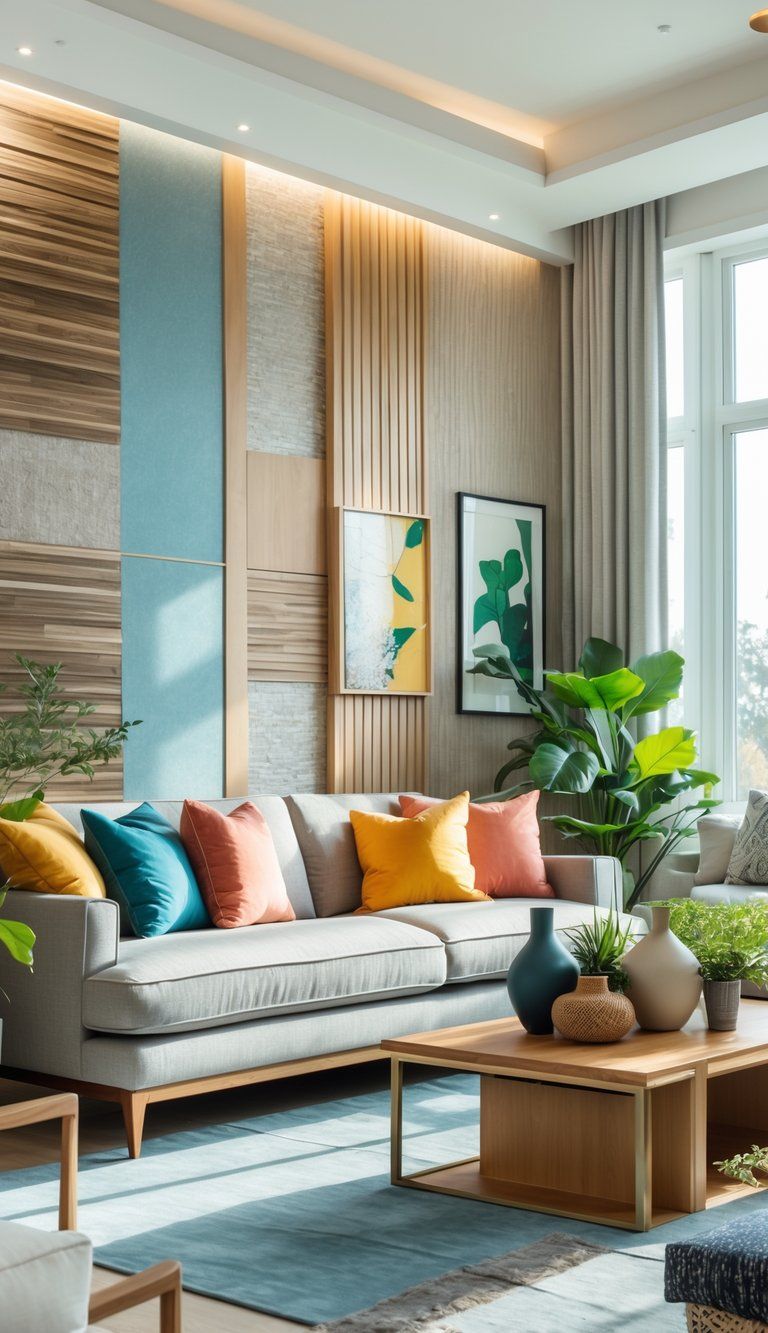
Wall treatments shouldn’t feel like an afterthought—they need to fit with everything else. When you blend them well, your space feels intentional and pulled together.
Coordinating With Furniture and Accessories
When picking wall treatments, look at your existing furniture. Wood paneling pairs well with mid-century styles, and textured wallpaper is a great match for modern pieces.
Try colors that match or deliberately contrast with your big furniture items. Got a navy blue sofa? Go for walls in neutral shades or something bold that pops.
Art placement matters with textured walls. For shiplap or board-and-batten, hang art between the boards at eye level. With wallpaper, pick art that echoes the pattern’s colors to keep things looking cohesive.
Don’t forget about scale. Bold geometric walls work best with simple furniture. Subtle textures let statement pieces stand out.
Enhancing Overall Interior Design
Wall treatments really set the tone for your space. They help bring your design vision to life.
You can use them to carve out zones, especially in open floor plans. For example, maybe try shiplap in the dining area, then use painted walls for the living room. That way, you get a clear sense of where one space ends and another begins.
Lighting totally changes the vibe of any wall treatment. Always test samples in different lighting before you make a final decision.
Textured walls come alive when you shine light across them from the side. On the other hand, glossy finishes bounce light around and make a room feel brighter.
Wall treatments also mess with our sense of space. If you go for horizontal designs, the room feels wider. Vertical patterns? They trick the eye and make low ceilings seem taller.
Layering textures adds so much depth. If your walls are smooth, toss in some textured pillows, a cozy throw, or a chunky rug. Suddenly, everything feels more balanced and interesting.

